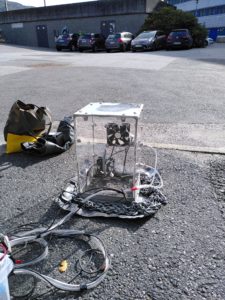By Joseph Gaudard
We were getting some strange looks while measuring ecosystem carbon fluxes on… the parking lot of the university. And for a reason: what would one expect to respire on clean asphalt? Nothing or almost. So what was I doing here, with my whole setup and four students? Well, the most important thing a university has to do: sharing knowledge!
For the purpose of a course, those students had to come with a short project that would make them discover part of my research. Since I work on ecosystem carbon fluxes, and we are in a city, it was a great opportunity to compare the carbon fluxes of different land cover surfaces that are present in the city. We measured the mosses in between our buildings, the lawn in the park, some damaged bare ground in the park as well, an accumulation of dead leaves and… a parking lot. Why the parking lot? Asphalt is the predominant surface cover in the city, therefore we felt it was important to include it in the comparison.
The way we measured those carbon fluxes is the same that I do on the field. We use a closed loop chamber system connected to a gas analyser. A what!? A plexiglas chamber that is connected with some tubes to a gas analyzer, a device that is recording the CO2 concentration every seconds (I show it here in a video ). A pump is making the air circulate in between the chamber and the gas analyzer. Inside the chamber, a small fan is mixing the air. The chamber is open on its lower side, but when it is put on the ground and made air tight using a heavy chain, the system is closed. The only input or output is from the ecosystem. Either the ecosystem is emitting CO2, and therefore increasing the CO2 concentration inside the system, or taking up carbon and therefore decreasing the CO2 concentration inside the system. This increase or decrease is what we use to calculate the flux (in mmol/h/m2) carbon in the ecosystem.

